 Do You Remember That Day in December?
Do You Remember That Day in December?
Of course the name of photographer R. Umar Abbasi rings a bell. After all, he made headlines two years ago, on December 4, 2012, right?
Doesn’t spring readily to mind? How soon they forget. This episode has become merely a footnote to other similar but more recent subway crimes. Predictably, the pack of haters who bayed at Abbasi so loudly late that year for making the briefly controversial “subway death photo” of Korean immigrant Ki-Suck Han moments before a Q train struck and killed Han at the 49th St. station in Manhattan on December 3, quickly moved on to whatever new flavor-of-the-day outrages have since sparked their ire. Or, perhaps, they let themselves get distracted by the newsworthy doings of Honey Boo Boo, Kim Kardashian and Kanye West, and/or Snooki & JWoww.
Han’s killer, Naeem Davis, an immigrant from Sierra Leone described as “a devout Muslim who prays five times a day and goes to mosque daily,” told police that, his faith notwithstanding, he was high on marijuana, angry that an acquaintance had thrown away his Timberland boots, and hearing voices when he threw Han to his death. (As of July 2013, Davis faced charges of second-degree murder and manslaughter. Han’s family sued the Metropolitan Transportation Authority for negligence. I haven’t discovered the outcome of either case.)
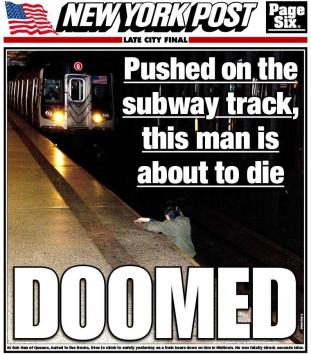
New York Post cover, subway death, 12-4-12. Photograph by R. Umar Abbasi.
The short-lived debate that erupted around Abbasi’s making and licensing of the image, and the front-page publication thereof by the New York Post on December 4, proved dishearteningly dumb overall. Not unexpected, yet nonetheless another instance in which a potential teaching moment related to photography got mostly squandered by the mainstream media — in this case, one concerning the ethics of making and publishing images of people in extremis, and the interventionist obligations (if any) of witnesses to such situations.
Mary Elizabeth Williams’s December 5, 2012 op-ed for Salon, “The New York Post defends its indefensible photo,” can stand in for all the let’s-demonize-the-photographer-and-the-newspaper indignation, while David Sirota’s In These Times piece from December 7, 2012, “A Picture Worth Far More Than 1,000 Words,” along with James Poniewozik’s “We Are a Camera: Life, Death and the Urge to Shoot” for the December 5, 2012 issue of TIME, exemplify the classic white-liberal we-are-all-guilty handwringing end of the commentary spectrum on this incident, as the subhead of the latter (“How the New York Post subway photo turns the lens on us”) makes clear.
It pleases me that some writers with a wider audience responded in level-headed ways. One exception to the general mindless yapping: “Tabloid photographers defend colleague who snapped ‘Post’ subway horror shot,” by Joe Pompeo, at Capital, published on December 4, 2012 — responses from colleagues of Abbasi’s who, given the howling for blood of the wolfpack at that moment, opted to remain anonymous.
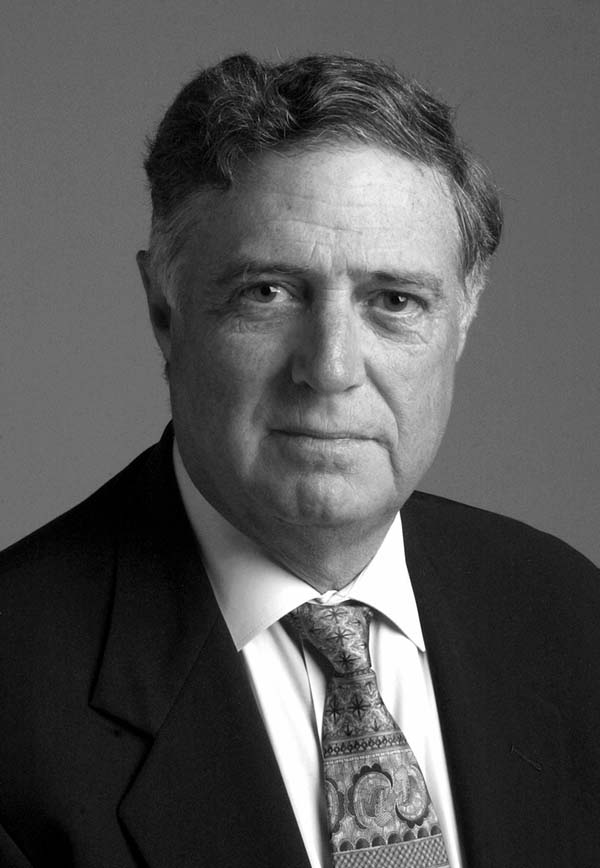
John Long, NPPA Ethics Committee chairman, official portrait.
But their thoughtful statements don’t differ much from those of the majority of identified voices heard in “Would You Have Taken the Post Subway Photo?: Pulitzer-Winning Photographers Respond,” assembled by Cord Jefferson for Gawker on December 12, 2012. Jefferson’s respondents are named. What a concept — asking actual working photographers to assess the situation and Abbasi’s response thereto. (By contrast, John Long of the National Press Photographers Association achieved the height of holier-than-thou hypocrisy, in the name of the NPPA’s membership.)
Here’s another oasis of sanity: “What Disturbs Us Most About the N.Y. Post Subway Death Cover,” by J. Bryan Lowder, at Slate, December 4, 2012. (Slate followed up with a meditation by Dan Gillmor, “Prepare for the New Cameras-Everywhere World,” subtitled “New technology means we’ll only see more images like the New York Post subway-death photo,” on December 12, 2012.)
Even a college student like Mike Pedersen has a nuanced perspective; witness “Plight of the Photojournalist: An Opinion,” at the Stony Brook Independent website. “For students journalists like myself, a skill we definitely need to develop is a tolerance of disrespect towards our line of work. What people need to understand and what students need to believe in, is that journalists help in our own way. It’s an indirect way of helping, but it’s help nonetheless,” he writes.
R. Umar Abbasi ≠ Kevin Carter (Ever)
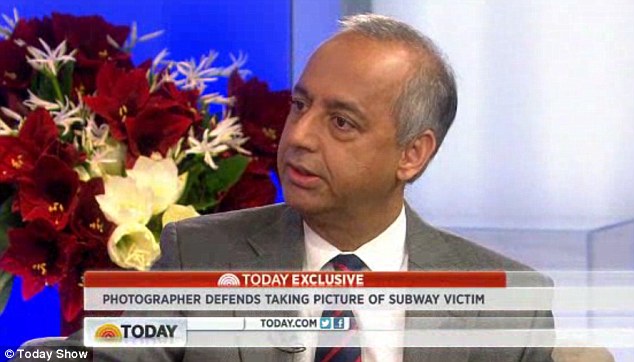
R. Umar Abbasi, Today Show, 12-5-12, screenshot.
I’ve done my best in this series of posts to bring a more considered and informed perspective to bear, but nowadays I’m at best a marginalized contributor to the mainstream dialogue, not someone with a bully pulpit. Nonetheless, I soldier on, “putting my queer shoulder to the wheel,” as Allen Ginsberg once wrote.
Having already weighed in on various aspects of the subway-photo situation, I turn again to the odious comparisons made between Abbasi and Kevin Carter, with whom he was regularly equated as exemplifying what I’ll call “bad photographer” behavior, and Nick Ut, frequently presented as a counter-example of “good photographer” behavior. Carter, I remind you, made a stark 1993 image of a starving Sudanese child crawling toward a rescue station and, upon its publication, received widespread condemnation for not somehow “helping” the girl. Ut photographed a napalmed little girl in Vietnam in 1972, then doused her with water and helped her get to a field hospital.
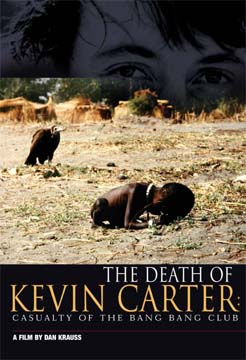
“The Death of Kevin Carter: Casualty of the Bang Bang Club” (2004), directed by Dan Krauss, poster.
Abbasi is a middle-aged New York-based freelance jack-of-all-trades photographer who seems never to have covered breaking news or any sort of conflict until he made that image. Thus he had little if any preparation for taking any kind of action, instinctive or deliberated, photographic or otherwise, in an unforeseen crisis. Kevin Carter was an ambitious, daring front-line photojournalist, a member of South Africa’s legendary “Bang-Bang Club” of photographers who chased the action and put themselves in harm’s way. They, the situations in which they made what became their defining images, and those images themselves, couldn’t be more different.
Yet equating Abbasi’s quick decision with Carter’s deliberated one, suggesting that those two images are comparable, and judging them both as instances and evidence of moral failure, serves as one recurrent theme in the discussion of Abbasi’s image and what we might call the responsibilities of the photographer as citizen.
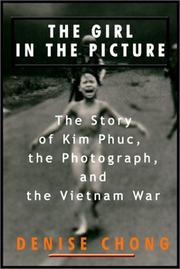
Denise Chong, “The Girl in the Picture” (2000), cover.
The other comparison made frequently in this debate contrasts Abbasi’s and Carter’s maintenance of their observer status in those situations with Nick Ut’s rendering of assistance to the napalm-injured Kim Phuc in Vietnam in 1972. I don’t consider Abbasi’s making of this subway image analogous to Carter’s making of his, nor counter-analogous to Nick Ut’s actions in relation to the napalmed little girl.
So I find confounding Zeynep Tufekci’s bizarre, unworkable set of guidelines for photojournalists at her blog Technosociology, “Yes, Graphic Photos Should be Published but New York Post was Wrong to Publish Victim on Tracks” (December 5, 2012). Take her Rule 1:
“If the photo represents a choice between potential saving a life, or clicking, that photo should not be purchased, monetized or paid for. The split-second decision is for the photographer to make — what level of danger can we impose on other people? — but the decision to purchase is clear. It should not be purchased. *IF* NY Post paid for that photo, that is wrong.”
Nor do I agree with, or even understand, Kelly McBride‘s befuddled argument that “[Ut’s and Carter’s] photos held significant journalistic purpose of informing the public of gross tragedies and holding the powerful accountable. This photo doesn’t have any of those redeeming journalistic qualities. But it causes great harm, to the family of the man, to those of us who view it and to the community of New York.” (“Would you snap a picture or pull the man to safety?” at the Poynter Institute blog, December 5, 2012.) In what possible ways did Ut’s and Carter’s images “hold the powerful accountable”? What conceivable “great harm” did Abbasi’s photos do to “the family of the man, to those of us who view it and to the community of New York”? This constitutes nothing more than jejune, fatuous rhetorical posturing.
Kevin Carter ≠ “Kevin Carter”
 Houston FotoFest International, the U.S. biennial, commissioned an installation by Alfredo Jaar, “The Sound of Silence,” which I saw at its premiere there in spring 2006. It presented itself as a meditation on Carter’s Sudan image. Roberta Smith’s April 14, 2009 New York Times review of its New York debut, “One Image of Agony Resonates in Two Lives,” includes a detailed description of it. (For a long discussion of the making of this piece, from a 2009 issue of The Brooklyn Rail, click here. For a PDF of the text that plays on its screen, click here.)
Houston FotoFest International, the U.S. biennial, commissioned an installation by Alfredo Jaar, “The Sound of Silence,” which I saw at its premiere there in spring 2006. It presented itself as a meditation on Carter’s Sudan image. Roberta Smith’s April 14, 2009 New York Times review of its New York debut, “One Image of Agony Resonates in Two Lives,” includes a detailed description of it. (For a long discussion of the making of this piece, from a 2009 issue of The Brooklyn Rail, click here. For a PDF of the text that plays on its screen, click here.)
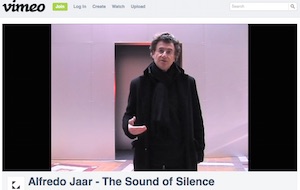
Alfredo Jaar explains “The Sound of Silence,” 2011 video, screenshot
I found “The Sound of Silence” mawkish and manipulative, akin in its smarminess to “A Hundred Times Nguyen,” a 1994 work by Jaar — nothing more than cheap sentiment masquerading as sociopolitical engagement. In it Jaar implies simplistically that Carter’s suicide stemmed from guilt over that one picture’s success (echoed eerily by the Abbasi-haters, who basically proposed that he should kill himself for responding as he did to the situation in the subway two years ago). The truth, as so often happens, is more complex. Carter’s suicide note speaks of the psychic burden of years of accumulated horror; he blamed himself for the recent death of his close friend and colleague Ken Oosterbroek; and it’s hardly clear that the bile poured over him for that one photo, or any remorse over receiving an award for making it, proved the last straw.
•
We — not we in the U.S., nor we in the west, but we as a species — need those among us willing not just to watch but to witness, and sometimes to bear witness, to even the most terrible events. We do not encourage and support them by insisting that, beyond that commitment, they have some vague moral obligation to intervene as well, or by second-guessing their necessarily quick decisions on that score in fraught and dangerous situations.
In 2000 the British poet U.A. Fanthorpe concluded an essay titled “War, Poetry, the Child”* with this advice for poets, which applies no less to photographers:
[W]hen you are ready, you will be summoned, as the great Russian poet Anna Akhmatova was. During the Stalinist terror, she was waiting in a line outside the Leningrad prison where her son was detained.
A woman with blue lips standing behind me … suddenly woke out of the benumbed condition in which we all found ourselves at that time and whispered in my ear (in those days we all spoke in a whisper):
— Can you put this into words?
And I said:
— I can.
We all have to be ready for that moment when the woman with blue lips turns to us.
I suggest we put our energies into preparing our assigned and volunteer witnesses for those moments by making them aware of how much we value their service to us when they put “this” into words or pictures or any other form. We do them no justice, and ourselves neither favors nor honor, by proclaiming that fulfilling their designated roles as witnesses marks them as failed human beings. As Robert Capa once said, “It’s not easy always to stand aside and be unable to do anything except record the sufferings around one.”**
*In the anthology Strong Words: Modern Poets on Modern Poetry, edited by W. N. Herbert and Matthew Hollis, Bloodaxe Books, 20o0, p. 210.
**In Images of War: Photographs by Robert Capa, with texts from his own writings, Grossman, 1964.
Not the Race Card
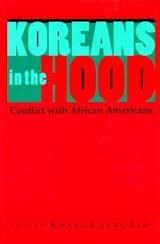
Koreans in the Hood, ed. by Kwang Chung Kim (1999). cover.
One subscriber to this blog emailed me to ask, “Had the perpetrator [of the subway crime] been white, and the victim white, would you have mentioned their skin color?” (I did so in my first post on this subject.)
A fair question. My response: Han’s identity as a Korean immigrant is certainly part of the narrative. There’s long-standing hostility toward Koreans in the NYC black community and elsewhere (witness the 1992 riots in LA), which may have played a role in this conflict. Because the ethnicities of Davis and Han have featured prominently in all the news coverage and commentary, it seemed appropriate to mention them in mine.
Would I have done so if both protagonists had been white? There aren’t presently or recently equivalent simmering tensions in New York City between different Caucasian ethnicities — say, Italian-Americans and Irish-Americans. So no, I wouldn’t nowadays mention such matters unless it appeared they might pertain. However, such frictions did once exist, and played major roles in the city’s social dynamics. Had I been a journalist or commentator back then, I’d have considered such mention appropriate.
As it happens, I misidentified Davis, the alleged perpetrator, as an African-American man, based on one or more of the accounts I read. Turns out he is a refugee from Sierra Leone who came to the States as a 7-year old. I’ve made the necessary correction in that first post. Had I know his immigrant status and country of origin, I’d have indicated that instead. As recent events have proved, even here in the fabled melting pot of NYC we don’t live in post-racial, post-ethnic, post-geographic harmony; people’s skin colors and places of origin often figure in their stories. It would be naïve to pretend otherwise.
•
(For an index of links to all posts in this series, click here.)
•
This post supported by a donation from Yoshio Kishi.
The Photographer as Citizen (4)
Of course the name of photographer R. Umar Abbasi rings a bell. After all, he made headlines two years ago, on December 4, 2012, right?
Doesn’t spring readily to mind? How soon they forget. This episode has become merely a footnote to other similar but more recent subway crimes. Predictably, the pack of haters who bayed at Abbasi so loudly late that year for making the briefly controversial “subway death photo” of Korean immigrant Ki-Suck Han moments before a Q train struck and killed Han at the 49th St. station in Manhattan on December 3, quickly moved on to whatever new flavor-of-the-day outrages have since sparked their ire. Or, perhaps, they let themselves get distracted by the newsworthy doings of Honey Boo Boo, Kim Kardashian and Kanye West, and/or Snooki & JWoww.
Han’s killer, Naeem Davis, an immigrant from Sierra Leone described as “a devout Muslim who prays five times a day and goes to mosque daily,” told police that, his faith notwithstanding, he was high on marijuana, angry that an acquaintance had thrown away his Timberland boots, and hearing voices when he threw Han to his death. (As of July 2013, Davis faced charges of second-degree murder and manslaughter. Han’s family sued the Metropolitan Transportation Authority for negligence. I haven’t discovered the outcome of either case.)
New York Post cover, subway death, 12-4-12. Photograph by R. Umar Abbasi.
The short-lived debate that erupted around Abbasi’s making and licensing of the image, and the front-page publication thereof by the New York Post on December 4, proved dishearteningly dumb overall. Not unexpected, yet nonetheless another instance in which a potential teaching moment related to photography got mostly squandered by the mainstream media — in this case, one concerning the ethics of making and publishing images of people in extremis, and the interventionist obligations (if any) of witnesses to such situations.
Mary Elizabeth Williams’s December 5, 2012 op-ed for Salon, “The New York Post defends its indefensible photo,” can stand in for all the let’s-demonize-the-photographer-and-the-newspaper indignation, while David Sirota’s In These Times piece from December 7, 2012, “A Picture Worth Far More Than 1,000 Words,” along with James Poniewozik’s “We Are a Camera: Life, Death and the Urge to Shoot” for the December 5, 2012 issue of TIME, exemplify the classic white-liberal we-are-all-guilty handwringing end of the commentary spectrum on this incident, as the subhead of the latter (“How the New York Post subway photo turns the lens on us”) makes clear.
It pleases me that some writers with a wider audience responded in level-headed ways. One exception to the general mindless yapping: “Tabloid photographers defend colleague who snapped ‘Post’ subway horror shot,” by Joe Pompeo, at Capital, published on December 4, 2012 — responses from colleagues of Abbasi’s who, given the howling for blood of the wolfpack at that moment, opted to remain anonymous.
John Long, NPPA Ethics Committee chairman, official portrait.
But their thoughtful statements don’t differ much from those of the majority of identified voices heard in “Would You Have Taken the Post Subway Photo?: Pulitzer-Winning Photographers Respond,” assembled by Cord Jefferson for Gawker on December 12, 2012. Jefferson’s respondents are named. What a concept — asking actual working photographers to assess the situation and Abbasi’s response thereto. (By contrast, John Long of the National Press Photographers Association achieved the height of holier-than-thou hypocrisy, in the name of the NPPA’s membership.)
Here’s another oasis of sanity: “What Disturbs Us Most About the N.Y. Post Subway Death Cover,” by J. Bryan Lowder, at Slate, December 4, 2012. (Slate followed up with a meditation by Dan Gillmor, “Prepare for the New Cameras-Everywhere World,” subtitled “New technology means we’ll only see more images like the New York Post subway-death photo,” on December 12, 2012.)
Even a college student like Mike Pedersen has a nuanced perspective; witness “Plight of the Photojournalist: An Opinion,” at the Stony Brook Independent website. “For students journalists like myself, a skill we definitely need to develop is a tolerance of disrespect towards our line of work. What people need to understand and what students need to believe in, is that journalists help in our own way. It’s an indirect way of helping, but it’s help nonetheless,” he writes.
R. Umar Abbasi ≠ Kevin Carter (Ever)
R. Umar Abbasi, Today Show, 12-5-12, screenshot.
I’ve done my best in this series of posts to bring a more considered and informed perspective to bear, but nowadays I’m at best a marginalized contributor to the mainstream dialogue, not someone with a bully pulpit. Nonetheless, I soldier on, “putting my queer shoulder to the wheel,” as Allen Ginsberg once wrote.
Having already weighed in on various aspects of the subway-photo situation, I turn again to the odious comparisons made between Abbasi and Kevin Carter, with whom he was regularly equated as exemplifying what I’ll call “bad photographer” behavior, and Nick Ut, frequently presented as a counter-example of “good photographer” behavior. Carter, I remind you, made a stark 1993 image of a starving Sudanese child crawling toward a rescue station and, upon its publication, received widespread condemnation for not somehow “helping” the girl. Ut photographed a napalmed little girl in Vietnam in 1972, then doused her with water and helped her get to a field hospital.
“The Death of Kevin Carter: Casualty of the Bang Bang Club” (2004), directed by Dan Krauss, poster.
Abbasi is a middle-aged New York-based freelance jack-of-all-trades photographer who seems never to have covered breaking news or any sort of conflict until he made that image. Thus he had little if any preparation for taking any kind of action, instinctive or deliberated, photographic or otherwise, in an unforeseen crisis. Kevin Carter was an ambitious, daring front-line photojournalist, a member of South Africa’s legendary “Bang-Bang Club” of photographers who chased the action and put themselves in harm’s way. They, the situations in which they made what became their defining images, and those images themselves, couldn’t be more different.
Yet equating Abbasi’s quick decision with Carter’s deliberated one, suggesting that those two images are comparable, and judging them both as instances and evidence of moral failure, serves as one recurrent theme in the discussion of Abbasi’s image and what we might call the responsibilities of the photographer as citizen.
Denise Chong, “The Girl in the Picture” (2000), cover.
The other comparison made frequently in this debate contrasts Abbasi’s and Carter’s maintenance of their observer status in those situations with Nick Ut’s rendering of assistance to the napalm-injured Kim Phuc in Vietnam in 1972. I don’t consider Abbasi’s making of this subway image analogous to Carter’s making of his, nor counter-analogous to Nick Ut’s actions in relation to the napalmed little girl.
So I find confounding Zeynep Tufekci’s bizarre, unworkable set of guidelines for photojournalists at her blog Technosociology, “Yes, Graphic Photos Should be Published but New York Post was Wrong to Publish Victim on Tracks” (December 5, 2012). Take her Rule 1:
“If the photo represents a choice between potential saving a life, or clicking, that photo should not be purchased, monetized or paid for. The split-second decision is for the photographer to make — what level of danger can we impose on other people? — but the decision to purchase is clear. It should not be purchased. *IF* NY Post paid for that photo, that is wrong.”
Nor do I agree with, or even understand, Kelly McBride‘s befuddled argument that “[Ut’s and Carter’s] photos held significant journalistic purpose of informing the public of gross tragedies and holding the powerful accountable. This photo doesn’t have any of those redeeming journalistic qualities. But it causes great harm, to the family of the man, to those of us who view it and to the community of New York.” (“Would you snap a picture or pull the man to safety?” at the Poynter Institute blog, December 5, 2012.) In what possible ways did Ut’s and Carter’s images “hold the powerful accountable”? What conceivable “great harm” did Abbasi’s photos do to “the family of the man, to those of us who view it and to the community of New York”? This constitutes nothing more than jejune, fatuous rhetorical posturing.
Kevin Carter ≠ “Kevin Carter”
Alfredo Jaar explains “The Sound of Silence,” 2011 video, screenshot
I found “The Sound of Silence” mawkish and manipulative, akin in its smarminess to “A Hundred Times Nguyen,” a 1994 work by Jaar — nothing more than cheap sentiment masquerading as sociopolitical engagement. In it Jaar implies simplistically that Carter’s suicide stemmed from guilt over that one picture’s success (echoed eerily by the Abbasi-haters, who basically proposed that he should kill himself for responding as he did to the situation in the subway two years ago). The truth, as so often happens, is more complex. Carter’s suicide note speaks of the psychic burden of years of accumulated horror; he blamed himself for the recent death of his close friend and colleague Ken Oosterbroek; and it’s hardly clear that the bile poured over him for that one photo, or any remorse over receiving an award for making it, proved the last straw.
•
We — not we in the U.S., nor we in the west, but we as a species — need those among us willing not just to watch but to witness, and sometimes to bear witness, to even the most terrible events. We do not encourage and support them by insisting that, beyond that commitment, they have some vague moral obligation to intervene as well, or by second-guessing their necessarily quick decisions on that score in fraught and dangerous situations.
In 2000 the British poet U.A. Fanthorpe concluded an essay titled “War, Poetry, the Child”* with this advice for poets, which applies no less to photographers:
I suggest we put our energies into preparing our assigned and volunteer witnesses for those moments by making them aware of how much we value their service to us when they put “this” into words or pictures or any other form. We do them no justice, and ourselves neither favors nor honor, by proclaiming that fulfilling their designated roles as witnesses marks them as failed human beings. As Robert Capa once said, “It’s not easy always to stand aside and be unable to do anything except record the sufferings around one.”**
*In the anthology Strong Words: Modern Poets on Modern Poetry, edited by W. N. Herbert and Matthew Hollis, Bloodaxe Books, 20o0, p. 210.
**In Images of War: Photographs by Robert Capa, with texts from his own writings, Grossman, 1964.
Not the Race Card
Koreans in the Hood, ed. by Kwang Chung Kim (1999). cover.
One subscriber to this blog emailed me to ask, “Had the perpetrator [of the subway crime] been white, and the victim white, would you have mentioned their skin color?” (I did so in my first post on this subject.)
A fair question. My response: Han’s identity as a Korean immigrant is certainly part of the narrative. There’s long-standing hostility toward Koreans in the NYC black community and elsewhere (witness the 1992 riots in LA), which may have played a role in this conflict. Because the ethnicities of Davis and Han have featured prominently in all the news coverage and commentary, it seemed appropriate to mention them in mine.
Would I have done so if both protagonists had been white? There aren’t presently or recently equivalent simmering tensions in New York City between different Caucasian ethnicities — say, Italian-Americans and Irish-Americans. So no, I wouldn’t nowadays mention such matters unless it appeared they might pertain. However, such frictions did once exist, and played major roles in the city’s social dynamics. Had I been a journalist or commentator back then, I’d have considered such mention appropriate.
As it happens, I misidentified Davis, the alleged perpetrator, as an African-American man, based on one or more of the accounts I read. Turns out he is a refugee from Sierra Leone who came to the States as a 7-year old. I’ve made the necessary correction in that first post. Had I know his immigrant status and country of origin, I’d have indicated that instead. As recent events have proved, even here in the fabled melting pot of NYC we don’t live in post-racial, post-ethnic, post-geographic harmony; people’s skin colors and places of origin often figure in their stories. It would be naïve to pretend otherwise.
•
(For an index of links to all posts in this series, click here.)
•
This post supported by a donation from Yoshio Kishi.